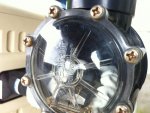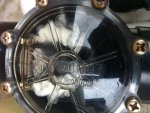My pool is barely 2 years old. It uses mostly Sta-Rite/Pentair equipments. A few days ago, I asked PB to come investigate what looked like a warped seal around a Pentair check valve flapper. PB came and confirmed the flapper did not look right and told me he would be coming back with a replacement cover/flapper. I've attached picture #1 here -> https://www.flickr.com/photos/49069808@N04/16063380102/in/set-72157647501207803 showing how it looked like inside the valve before it got replaced.
PB came today with a replacement part and removed the bad flapper. The bad flapper appears to have been attacked or damaged by either extreme concentration of chlorine from the Rainbow Chlorinator or hot water coming out of the heater. I've attached pictures #2 -> https://www.flickr.com/photos/49069808@N04/15878308927/in/set-72157647501207803 and #3 -> https://www.flickr.com/photos/49069808@N04/15877997119/in/set-72157647501207803 to show the warped flapper outside of it's check valve housing. As you can see from these pictures the spring would normally be silver since they are stainless steel, but the color now is yellow almost rusty. You can also see rust color stains around the clear plastic cover and the flapper itself. PB said he will send this bad flapper to the manufacturer for further investigation. I believe the PB chose to install this check valve in it's location in order to protect the heater from chlorine seepage from the Chlorinator (I've attached picture #4 -> https://www.flickr.com/photos/49069808@N04/15866624577/ to show it's proximity to both Chlorinator and Heater) .
(Please note I stopped using chlorine tabs and completely converted to BBB. Now using Liquid Chlorine since August of this year ~5 months)
Questions are:
1) What could have mangled the flapper?
2) Could strong concentrations of Chlorine from the rainbow chlorinator back flowed and attacked the flapper?
3) Since the check valve is in close proximity to the heater, would the hot water (max setting used was 84 deg f) from the heater melted it?
4) Since check valve's ability to stop water from back washing has been compromised, would you think the strong concentrations of chlorine
from the Rainbow 320 Chlorinator has back flowed into the water heater and could have attacked the heater elements?
PB came today with a replacement part and removed the bad flapper. The bad flapper appears to have been attacked or damaged by either extreme concentration of chlorine from the Rainbow Chlorinator or hot water coming out of the heater. I've attached pictures #2 -> https://www.flickr.com/photos/49069808@N04/15878308927/in/set-72157647501207803 and #3 -> https://www.flickr.com/photos/49069808@N04/15877997119/in/set-72157647501207803 to show the warped flapper outside of it's check valve housing. As you can see from these pictures the spring would normally be silver since they are stainless steel, but the color now is yellow almost rusty. You can also see rust color stains around the clear plastic cover and the flapper itself. PB said he will send this bad flapper to the manufacturer for further investigation. I believe the PB chose to install this check valve in it's location in order to protect the heater from chlorine seepage from the Chlorinator (I've attached picture #4 -> https://www.flickr.com/photos/49069808@N04/15866624577/ to show it's proximity to both Chlorinator and Heater) .
(Please note I stopped using chlorine tabs and completely converted to BBB. Now using Liquid Chlorine since August of this year ~5 months)
Questions are:
1) What could have mangled the flapper?
2) Could strong concentrations of Chlorine from the rainbow chlorinator back flowed and attacked the flapper?
3) Since the check valve is in close proximity to the heater, would the hot water (max setting used was 84 deg f) from the heater melted it?
4) Since check valve's ability to stop water from back washing has been compromised, would you think the strong concentrations of chlorine
from the Rainbow 320 Chlorinator has back flowed into the water heater and could have attacked the heater elements?



